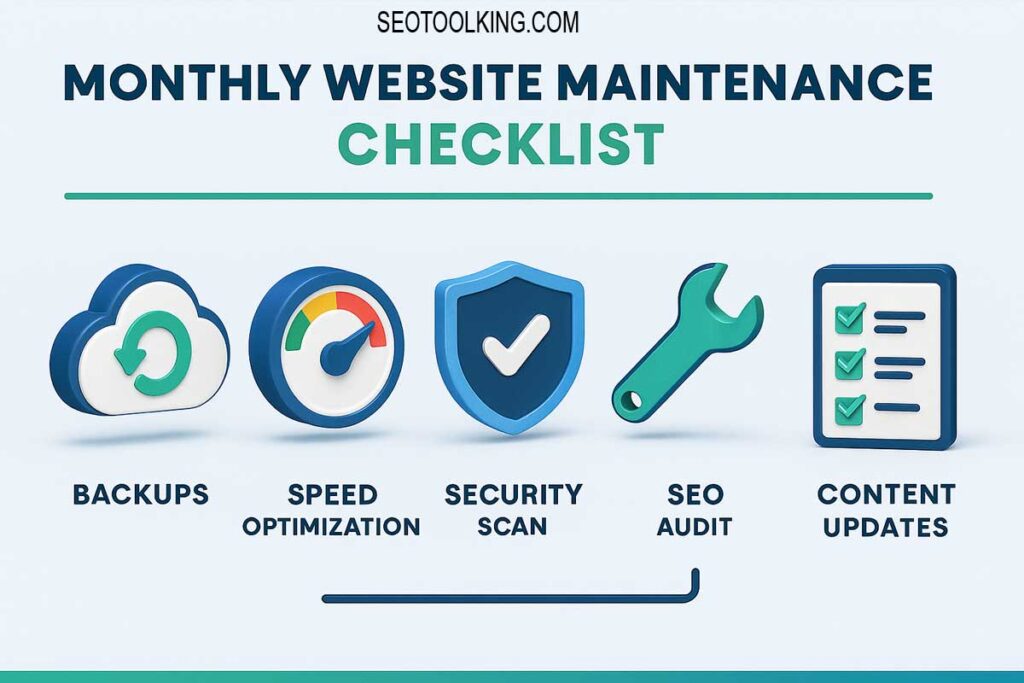Monthly Website Maintenance Checklist
Keeping your website healthy is like servicing a car — skip maintenance, and performance drops fast.
In today’s fast-moving digital world, regular website maintenance ensures your site remains secure, fast, and SEO-friendly.
This guide breaks down the ultimate monthly website maintenance checklist to help you keep your site at peak performance and ranking high on Google.
What Is Website Maintenance?
Website maintenance means regularly checking your website for issues, updating software, optimizing performance, and keeping it relevant for users and search engines.
It includes:
- Updating plugins and themes
- Fixing broken links and images
- Checking site speed and SEO
- Backing up files and databases
- Improving content and user experience
👉 For a full SEO audit, try our Free Website SEO Checker — it highlights speed issues, broken links, and ranking opportunities.
Why Monthly Website Maintenance Matters for SEO
Google rewards sites that are fresh, secure, and user-friendly.
If your website loads slowly, has outdated plugins, or broken links, your rankings can drop dramatically.
Key benefits of regular maintenance:
- ✅ Boosts site speed and Core Web Vitals
- ✅ Improves SEO ranking and crawlability
- ✅ Protects against hacking and malware
- ✅ Ensures better user experience (UX)
- ✅ Keeps your brand trustworthy and credible
💡 Example:
Imagine two websites selling digital marketing tools.
- Site A updates plugins, optimizes content, and checks speed monthly.
- Site B ignores maintenance for six months.
After three months, Site A loads in 1.3 seconds and ranks on page 1, while Site B takes 4.8 seconds and loses 40% of organic traffic.

The Ultimate Monthly Website Maintenance Checklist
Let’s go through every key area of your site that needs attention monthly.
1. Website Backup and Security Check
Why it matters:
If your site gets hacked or corrupted, a clean backup saves your business.
Checklist:
- Schedule automated backups (database + files)
- Store copies on cloud storage (Google Drive, Dropbox, etc.)
- Scan your site for malware or suspicious activity
- Update all themes, plugins, and CMS versions
🧰 Pro Tip:
Use tools like Wordfence, Sucuri, or Jetpack for website security scanning.
2. Website Speed & Performance Optimization
Why it matters:
Google’s Core Web Vitals measure how fast your site loads. A slow website = poor SEO.
Checklist:
- Test site speed with Google PageSpeed Insights
- Compress large images with tools like TinyPNG
- Minify CSS, JavaScript, and HTML
- Use a Content Delivery Network (CDN)
- Delete unused plugins or scripts
👉 Use our Website Speed Test Tool to analyze your loading time instantly.
3. Fix Broken Links and Redirects
Why it matters:
Broken links frustrate users and confuse Google crawlers.
Checklist:
- Scan for 404 errors
- Fix or redirect broken internal/external links
- Update outdated URLs or redirects
- Check for broken images or missing alt text
💡 Example:
If a product page URL changes, add a 301 redirect so visitors and Google don’t hit a dead end.
4. SEO Audit & Keyword Optimization
Why it matters:
SEO evolves constantly. Regular keyword updates keep your content relevant.
Checklist:
- Check meta titles and descriptions for accuracy
- Update keywords with current search trends
- Audit on-page SEO (H1, H2, image alt tags)
- Verify mobile responsiveness
- Ensure sitemap.xml and robots.txt are updated
👉 Try our On-Page SEO Checker for a free SEO report.
5. Update and Refresh Website Content
Why it matters:
Google loves fresh, informative content.
Checklist:
- Update outdated blog posts or statistics
- Add new articles or case studies
- Check internal linking and anchor text
- Remove duplicate or thin content
💡 Example:
If you published “SEO Trends 2025,” refresh it to “SEO Trends 2026” with new insights and keywords.
🧩 6. Technical SEO & Website Health
Why it matters:
Small technical errors can block Google from indexing your pages.
Checklist:
- Review Google Search Console for crawl errors
- Fix structured data issues (Schema)
- Validate HTTPS and SSL certificates
- Test mobile usability and AMP pages
🧰 Pro Tip:
Use Google Search Console + small-seo-tool.com’s Technical SEO Audit Tool for accurate health checks.
7. Check E-commerce Functionality (If Applicable)
Why it matters:
If your checkout process fails, your conversions plummet.
Checklist:
- Test add-to-cart, checkout, and payment gateways
- Update product pages and pricing
- Verify tax, shipping, and discount codes
- Review conversion tracking (Google Analytics, GA4)
8. Analyze Traffic and Performance Reports
Why it matters:
Analytics data reveals what’s working and what’s not.
Checklist:
- Review monthly traffic reports (Google Analytics or GA4)
- Track bounce rate and session duration
- Analyze top-performing pages
- Identify new keyword opportunities
website maintenance checklist, monthly website maintenance, SEO website maintenance, website security audit, website speed optimization, technical SEO checklist, fix broken links, WordPress maintenance tips, site updates
Example: Monthly Website Maintenance in Action
Scenario:
A marketing agency uses this checklist each month:
- Runs a site speed test → Fixes slow images.
- Finds 12 broken links → Redirects them.
- Updates SEO metadata on 10 pages.
- Publishes 2 new blogs.
Result after 2 months:
✅ Page speed improved by 37%
✅ Traffic up by 22%
✅ Bounce rate dropped by 15%
✅ Google rankings improved for 8 primary keywords
Suggestion
👉 Explore our related tools for ongoing SEO and maintenance success:
FAQs About Monthly Website Maintenance
Q1: How often should I maintain my website?
Perform a full check at least once a month, and weekly checks for backups and security updates.
Q2: Does website maintenance affect SEO?
Yes — regular updates help maintain speed, uptime, and keyword rankings.
Q3: What tools can I use for website maintenance?
Tools like small-seo-tool.com, Google Analytics, Ahrefs, and Wordfence are great choices.
Q4: How long does monthly website maintenance take?
Typically 2–4 hours per month for small sites, longer for e-commerce or enterprise sites.
Q5: What happens if I skip maintenance?
You risk hacks, SEO drops, broken pages, and lost conversions.
Conclusion
Your website isn’t a one-time project — it’s a living, evolving asset.
Following this monthly website maintenance checklist keeps your site secure, fast, SEO-optimized, and user-friendly.
Small improvements each month = massive growth over time.
👉 Start by running a Free SEO Website Audit today to identify issues before they impact your performance.


